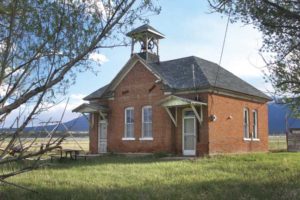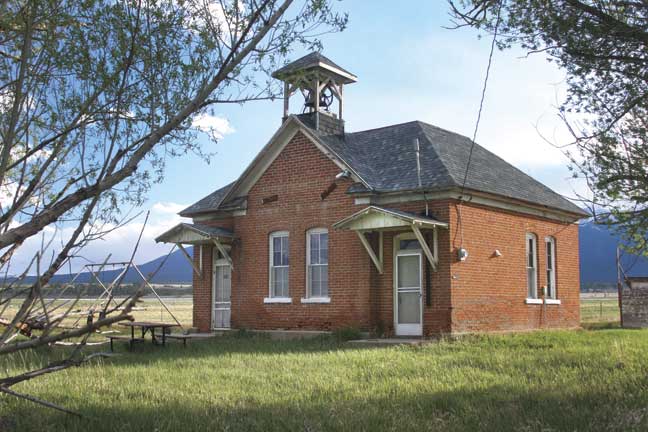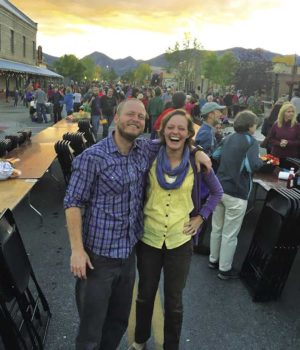By Virginia McConnell Simmons
With Mount Princeton and Mount Antero providing a serene backdrop, Gas Creek and Chalk Creek thread a valley lying north of Centerville, where U.S. Hwy. 285 drops down, passing under a water diversion pipe. This valley extends north to Cache Creek, which flows beneath the highway south of Nathrop. Here began local discord that, encompassing the nearby area, became known as the Lake County War.
When the following events took place, Gas Creek was part of Lake County, extending from the Continental Divide on the north and west, the Mosquito Range on the east, and Poncha Pass on the south. Leadville’s silver mines were not yet booming. But soon after the Pikes Peak gold rush and the Civil War, ranchers and farmers had started to take up land at Gas Creek, and irrigation ditches were being dug, some with affirmed legal rights and some without. Although a few of these early settlers had arrived as prospectors, they now were settling down with plows and cattle, returning to activities they had known “back home” in the Midwest and East.
It was a small world of early comers which the Gibbs family and others joined before long. Elijah Gibbs’ cabin was at Gas Creek, and his father had a place nearby. Elijah’s wife was the daughter of a Methodist preacher called Gilliland down at Brown’s Creek, a short distance south of Centerville, and another of Gilliland’s daughters was married to Justice of the Peace A.B. Cowan. Gilliland was an acquaintance of the well-known Methodist circuit rider, Rev. John L. Dyer, whose son Dyer taught school at Brown’s Creek. After a while, though, Elijah had moved, but only as far north as Granite, where he served as Probate Judge while also prospecting at Iowa Gulch near today’s Leadville.

In addition to others at Gas Creek, there were a couple of European immigrants. On the south end of the Gas Creek area, the Englishman George Harrington took up land in 1866 and built a two-story log house on the west side of today’s U.S. 285 at the foot of the hill. Harrington’s place was across the creek from Elijah Gibbs’.
At the northern end of the valley at Chalk Creek, an ambitious German, Charles Nachtrieb, also arrived in 1866 with his family, built a home, put in crops, and soon erected a gristmill on Chalk Creek, which flows under the highway bridge south of Nathrop. Besides farms in the Upper Arkansas area, the mill had customers from the northern part of the San Luis Valley, thanks to a toll road built in 1867 by Otto Mears of Saguache, and later owned in part by Nachtrieb. He was the most prominent resident at Gas Greek, with the mill at Chalk Creek and the store and post office nearby at Nathrop, where his name was altered to easier to pronunciation and spelling.
By the 1870s, older established settlers and newer people had their own friendly and less-friendly cliques. Some were regarded as ne’er-do-wells, and rustling of livestock rustling was rumored. With San Juan mining excitement taking place across the Divide, prospecting around Cache Creek and Granite also drew assorted adventurers through the region. And the original Lake County seat at Dayton on Twin Lakes had moved down to Granite, increasing its population and saloons.
[InContentAdTwo]
Gibbs, who had been dabbling at mining around Cache Creek in his spare time, returned home once to find his team being used for threshing by some neighbors without his permission, and squabbles naturally resulted. In 1874 Harrington and Gibbs had a row about water, which, Harrington claimed, Gibbs was taking from his ditch. Although armed, Gibbs did not fire his gun at Harrington, but the latter hit Gibbs with his shovel, so Harrington took Gibbs down to Justice of the Peace Cowan, Gibbs’ brother-in-law, who permitted Gibbs to go home because his wife was sick, he said.
After George and Helen Harrington had gone to bed that night, they were roused by a fire in their small store (or storehouse or privy?). While George was vainly battling flames with well water and a bucket, he was shot. Helen tried to pull the body from the flames, but too late. Accusing Gibbs and his hired man of murder, Harrington’s sympathizers hauled the pair to Probate Judge Elias Dyer in October. Judge Dyer believed Gibbs’ innocence, but vigorous protests erupted and a crowd gathered outside the courthouse.
Judge Dyer wisely, or fearfully, chose to refer the case to a Denver court, and Gibbs and the hired man set out for Denver, pursued by Sheriff Weldon and 76 vigilantes across South Park, with sympathetic ranchers assisting Gibbs along the way. At Monument, Gibbs caught a D&RG train to Denver, sought safety in the city’s jail, and was acquitted in the court.
Elijah, whose wife and children had remained at Gas Creek, returned home, and one night a gang of 15 surrounded his house and unsuccessfully attempted to set it afire, with Gibbs and his family inside. Gibbs fired shots at the would-be arsonists and killed three members of a large Boone clan – brothers David and Samuel and their uncle Finley Kane – and wounded another man. Afterward, Gibbs fled and never was seen again in the Upper Arkansas Valley.
During the winter and spring of 1875, a “Committee of Safety” of about 60 men terrorized the entire area. Abruptly evicting school children from class at Brown’s Creek one day, the Committee commandeered that building for their meetings. They hauled people to Nachtrieb’s mill for interrogation, and, trying to force confessions of support for Gibbs, they threatened lynching with ropes around necks, sufficiently to lift feet from the ground. Judge Dyer himself was one of those held overnight in the mill. An estimated 18 people died by one mysterious means or another during the months of hysteria.
For Judge Elias Dyer, this sorry tale ends when a mob of about 30 gathered at Granite on July 2, 1875. Dyer had issued warrants for the arrest of 20-some vigilantes, but then, fearing the consequences, he rescinded the order. Nonetheless, on the morning of July 3, when Dyer opened the court session, three men entered the courtroom on the second floor and shot him dead. Deputy Sheriff John Mear, who lived nearby and heard the shots, ran to the courthouse. As he went up the stairs, he saw William Kraft, John Coon and “Cy” Weston coming down.
Elias Dyer was buried at Granite, but his embittered father later reinterred the coffin at Castle Rock, rather than allow his son to remain among murderers in Lake County. An inquest was never held.
Addendum 1: In 1878 Harrington’s nephew, Bert Remington, who had been working for Charles Nachtrieb, came to the store for back pay, it has been said. At that time or immediately afterward, Nachtrieb was killed by Remington or an unidentified person.
Addendum 2: The Snow-Shoe Itinerant, the autobiography of the Rev. John L. Dyer, contains a detailed account with names and correspondence pertaining to the Lake County War. John Dyer inherited Elias’s half claim that had been worked with a partner in Iowa Gulch and sold the share to storekeeper Horace A.W. Tabor, a storekeeper in California Gulch who subsequently made a fortune.
Virginia McConnell Simmons is the author of The Upper Arkansas: A Mountain River Valley and numerous other books and articles about Colorado and the West.




